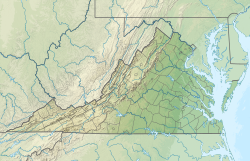Farrar's Island | |
|---|---|
 Reconstruction of early 17th-century house at Henricus Historical Park on Farrar's Island. | |
| Coordinates: 37°21′58″N 77°22′30″W / 37.366°N 77.375°W | |
| Location | Chesterfield County, Virginia |
| Elevation | 6 m |
Farrar's Island is a peninsula now on the west side of the James River in Chesterfield County, Virginia. The county operates the Dutch Gap Conservation Area and Boat Landing and as well as a living history museum, the Henricus Historical Park. Originally, Farrar's Island was formed by a meander loop in the James River and lay on the east side of the James River. At its smallest point, the neck of the peninsula was less than 400 feet (120 metres) wide. At that time, Farrar's Island was slightly less than 700 acres (280 hectares) and lay about 15 miles (24 km) south of the James River fall line at Richmond, Virginia.
Due to its strategic location on the river, the peninsula's neck became the site of the earliest English settlements in Virginia, Henricus, founded by Sir Thomas Dale in 1611, but basically abandoned by 1622. Farrar's Island acquired its name after 1637 when William Farrar obtained ownership as part of the headright due him for importing indentured servants to the colony. Farrar was a lawyer who also served on the Virginia governor's council and as a magistrate in the Crown Colony of Virginia. The Farrar family owned the peninsula until 1737 when a descendant sold it to Thomas Randolph.
During the last year of the American Civil War, Farrar's Island played a minor role in the Bermuda Hundred campaign. The James River along the peninsula anchored the left flank of Union General Benjamin Butler's defensive line. The area around Farrar's Island had river defenses by both Union and Confederate forces, each seeking to deny its enemy the use of the James River. The James River around Farrar's Island was also the site of one of the last major naval engagements of the war, the Battle of Trent's Reach. During the war, Farrar's Island became a true island when General Butler's troops built the Dutch Gap Canal, across the neck of the peninsula.
In the 1870s, the Dutch Gap Canal was expanded and become the main channel of the James River, which allowed shipping to bypass the meander loop around Farrar's Island. Construction of the canal put Farrar's Island on the west side of the James River, and it evolved into its present form as a tidal lagoon surrounded by woods and wetlands.

